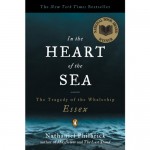On this date in 1820, a sperm whale attacked a whaling ship off the coast of South America. The Essex hailed from Nantucket, Massachusetts, and was captained by George Pollard Jr. Pollard was only 29, the youngest man to ever command a whaling ship; the Essex, by contrast, was pretty old, and she was also small for a whaleship. She was considered lucky, though, because crews made money on most of her voyages.
This particular voyage, which was to last two and a half years, didn’t start very auspiciously. Soon after leaving port en route to the whaling grounds off the west coast of South America, the ship was hit with a squall, lost her topgallant sail, and nearly sank. It took longer than usual to reach the whaling grounds, and the crew began to get edgy and superstitious. Then, when they finally arrived near the Galapagos Islands, they found the grounds nearly fished out. They struck out for a new whaling ground, but it was thousands of miles off the coast, much farther from land than whalers usually felt comfortable hunting. But the risk appeared to pay off when a pod of sperm whales was sighted on the morning of the 20th. The crew harpooned a couple of the whales, but then found themselves face to face with an enormous whale, which appeared to be acting strangely. The whale rammed the ship repeatedly; first mate Owen Chase later recounted, “I turned around and saw him about one hundred rods (550 yards) directly ahead of us, coming down with twice his ordinary speed (around 24 knots or 44 kph), and it appeared with tenfold fury and vengeance in his aspect. The surf flew in all directions about him with the continual violent thrashing of his tail. His head about half out of the water, and in that way he came upon us, and again struck the ship.” After crushing the bow, the whale swam off, never to be seen again.
The crew set off in some of the small whaleboats, but they didn’t have enough food or water. The captain wanted to sail west, to the Marquesas, but Owen and the crew believed the South Pacific was inhabited by cannibals, so they set off east, for South America, and this decision proved disastrous. By the time they arrived at the Pitcairn Islands, some of them had already died of thirst, and the survivors soon depleted the meager fish and bird population of the uninhabited island they landed on. The crew set out again in hope of rescue, but again, food ran out, and they resorted to cannibalism themselves, first eating the crew members who died, and then drawing lots to determine which living member they would sacrifice. By the time they were rescued by another whaling ship, they were completely out of their heads, and were terrified of their rescuers.
Owen Chase, who survived, wrote an account of the event, called The Narrative of the Most Extraordinary and Distressing Shipwreck of the Whale-Ship Essex (1821). Twenty years later, Chase’s son William met another seaman, Herman Melville, who had heard about the sinking of the Essex and asked him about it. William Chase gave Melville a copy of his father’s book. Melville read it while at sea, not far from the site of the original shipwreck, and it inspired his Moby-Dick.
from The Writer’s Almanac
